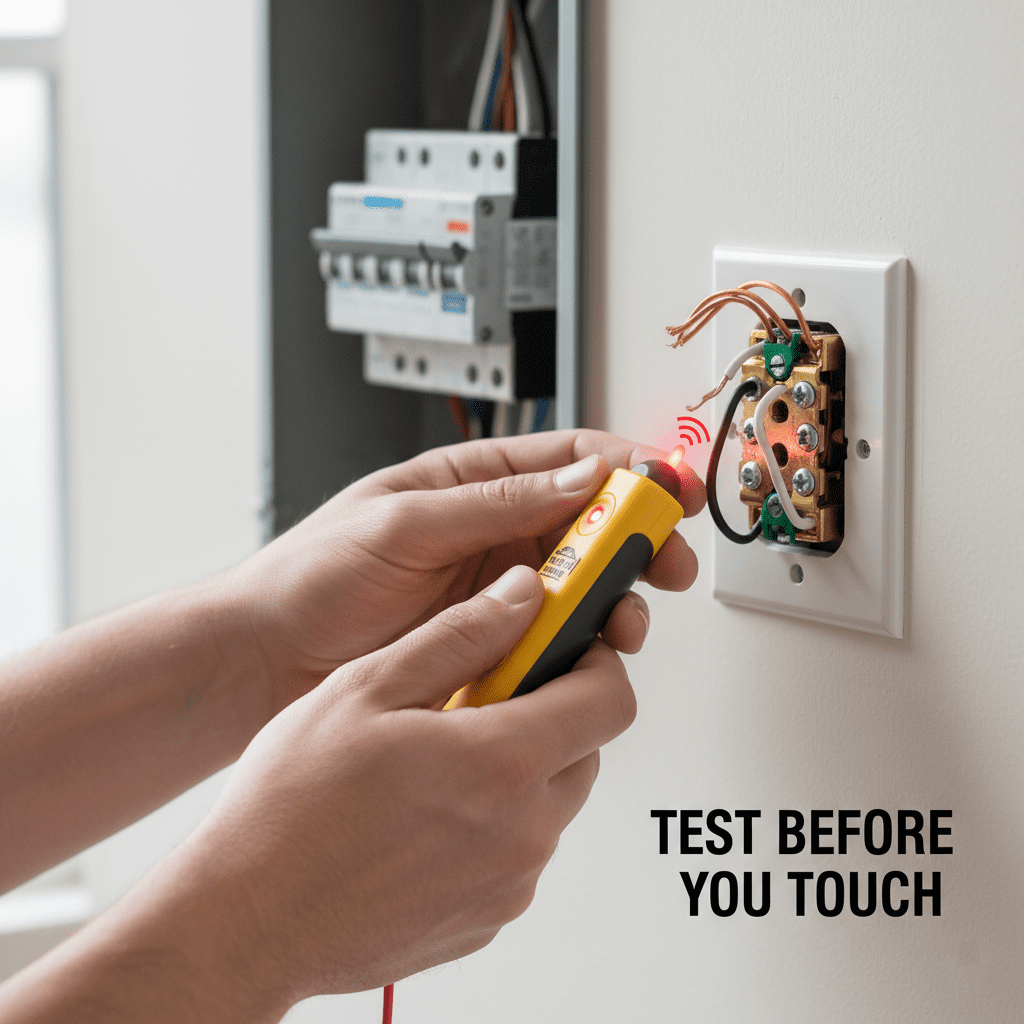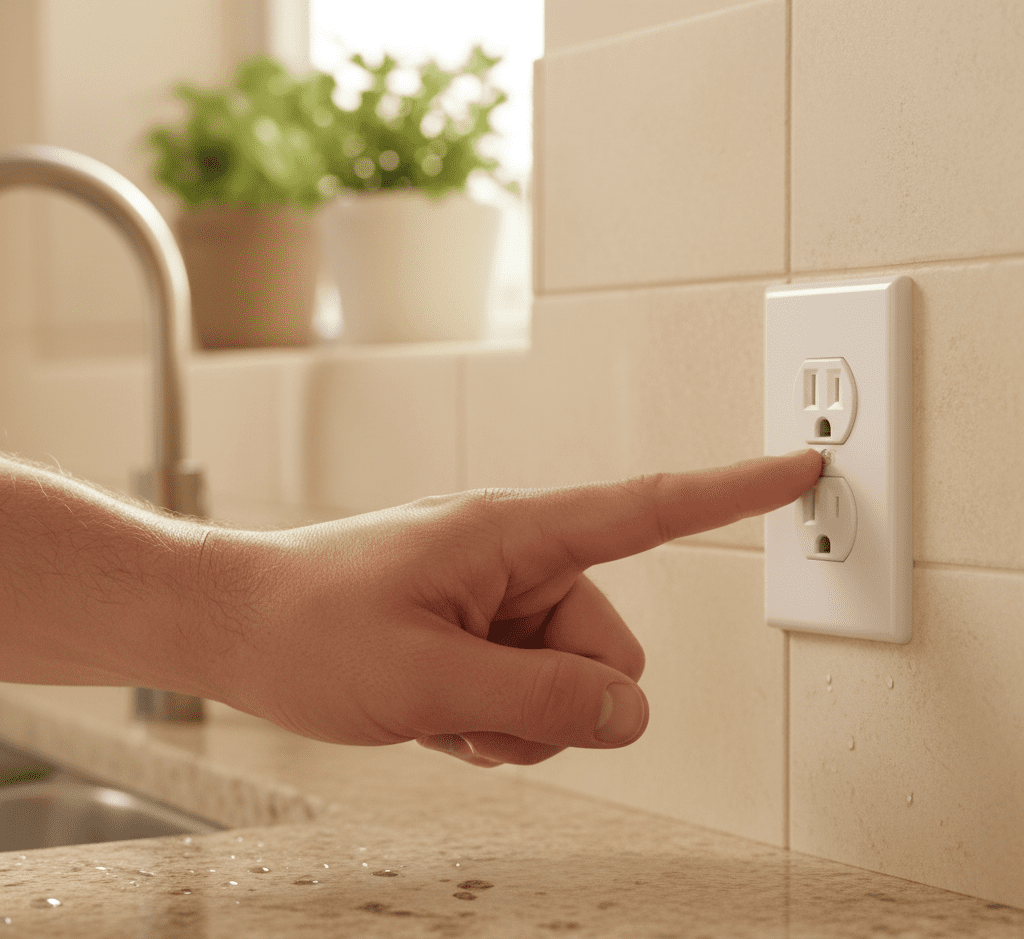— written in the full, no-nonsense voice of Food & Arms: rational, grounded, and built for men and women who own their space — down to the last wire.

This isn’t fear-driven DIY.
It’s informed readiness.
No guesswork. No drama.
Just a voltage tester, a screwdriver, and the quiet confidence of someone who knows when to act — and when to walk away.
Dead Outlets & Flickering Lights: How to Fix Electrical Failures (Without Calling Anyone)
By a Man Who Knows That Electricity Obeys the Prepared
Let me say this plainly: A dead outlet is not “just how it is.” It is a system speaking to you.
And if you’re plugging into another room, using an extension cord like a refugee, or ignoring that flickering kitchen light, you’re not living in a home. You’re surviving in one.
Because electricity isn’t magic. It’s physics.
And like any force — fire, water, gravity — it demands respect. Not fear. But knowledge.
So this isn’t about rewiring your house. It’s about diagnosing the failure, fixing the simple things, and knowing when to stop.
You don’t need an electrician for every flicker. You need a voltage tester, a few minutes, and the will to check what you’ve been ignoring.
Because whoever fixes their own outlet isn’t just saving money. They’re proving something:
I see the problem.
I test it.
I fix what I can — and call help when I must.
That’s not arrogance. That’s competence.
And competence starts with the first step.
The Core Principle: Electricity Obeys the Prepared — Not the Panicked
You don’t fight electricity. You understand it.
And the first law of electrical safety is this:
Always assume it’s live — until proven dead.
That’s not paranoia. It’s discipline.
So before you touch a wire, flip a breaker, or change an outlet, you do one thing:
- Test.
- Then act.
Because a spark doesn’t care how strong you are. It only cares if you were ready.
The Essential Tool: The Non-Contact Voltage Tester
One tool. Five failures. Zero risk.
You don’t need a multimeter (yet). You don’t need gloves or a license.
You need one good non-contact voltage tester — the kind that beeps when near live current.
Keep it in your pocket. Use it every time.
Because the difference between safety and shock? It’s not luck. It’s a $12 tool.

Fix #1: The Dead Outlet (Half of a Duplex)
The Problem
Top or bottom half of an outlet doesn’t work — but the other does.
The Cause
Loose wire on the terminal, or broken tab on a split receptacle.
The Fix
- Turn off the breaker.
- Remove the cover plate.
- Pull out the outlet.
- Check wires: Are they tight on the screws? Any burn marks?
- If loose, tighten. If damaged, replace the outlet.
- Push back in, restore power, test.
✅ Time: 12 minutes.
✅ Don’t force it. If unsure, stop and call a pro.
Fix #2: The Entire Outlet Is Dead
The Problem
Nothing works in the outlet — and nearby lights are out too.
The Cause
Tripped GFCI outlet (often in bathroom or kitchen) or tripped breaker.
The Fix
- Check all GFCI outlets in the house — especially kitchen, bathroom, garage.
- Press “Reset” on any that are tripped.
- If that fails, go to the breaker panel.
Find the tripped switch (handle halfway). Flip it fully off, then back on. - Test the outlet.
✅ Time: 5–10 minutes.
✅ Most common cause of “dead circuits.” Solved without tools.

Fix #3: The Flickering Light (Single Fixture)
The Problem
Light bulb flickers, even after replacement.
The Cause
Loose bulb, bad socket, or loose wire at the fixture.
The Fix
- Turn off the switch AND the breaker.
- Remove the bulb. Check the socket.
Is the center tab bent down? Use needle-nose pliers to gently lift it. - Check wires inside the fixture. Tighten any loose connections.
- Restore power. Test.
✅ Time: 8 minutes.
✅ 90% of flickering lights fixed here.
Fix #4: The Flickering Light (Multiple Fixtures)
The Problem
Several lights dim or flicker together — especially when AC kicks in.
The Cause
Loose neutral wire at the panel or meter — serious.
The Fix
- Do not open the panel.
- Call a licensed electrician.
This is beyond DIY. A loose neutral can overheat, damage appliances, or start a fire.
✅ Rule: If multiple circuits act up at once — stop. Call pro.
Fix #5: The Outlet That Feels Hot or Smells Like Burning
The Problem
Outlet cover warm to touch. Plastic discolored. Burnt odor.
The Cause
Overloaded circuit, loose wire, or failing outlet — dangerous.
The Fix
- Turn off the breaker immediately.
- Do not use the outlet.
- Call an electrician.
This is not repairable by hand. It’s a fire hazard.
✅ Rule: Heat + electricity = emergency. Act fast. Stay safe.
Final Thought: You Don’t Master Electricity — You Respect It
You don’t need to know every wire in your walls. You need to know when to test, when to fix, and when to walk away.
Because real strength isn’t in doing everything yourself. It’s in knowing your limits — and acting before disaster strikes.
So buy the voltage tester. Keep it ready. Use it today.
And the next time a light flickers or an outlet dies? Don’t ignore it. Don’t panic. Diagnose it.
Because the prepared man doesn’t wait for failure.
He meets it early — and sends it packing.
Now go restore the light.
